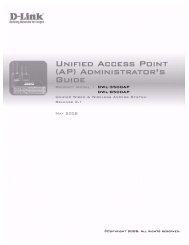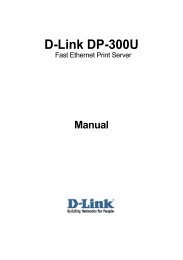Product Manual
Product Manual
Product Manual
You also want an ePaper? Increase the reach of your titles
YUMPU automatically turns print PDFs into web optimized ePapers that Google loves.
DES-3526 / DES-3526DC Fast Ethernet Layer 2 Switch<br />
been reset.<br />
Click Apply to implement changes made.<br />
QoS<br />
The DES-3526 supports 802.1p priority queuing Quality of Service. The following section discusses<br />
the implementation of QoS (Quality of Service) and benefits of using 802.1p priority queuing.<br />
Advantages of QoS<br />
QoS is an implementation of the IEEE 802.1p standard that allows network administrators a method of<br />
reserving bandwidth for important functions that require a large bandwidth or have a high priority,<br />
such as VoIP (voice-over Internet Protocol), web browsing applications, file server applications or<br />
video conferencing. Not only can a larger bandwidth be created, but other less critical traffic can be<br />
limited, so excessive bandwidth can be saved. The Switch has separate hardware queues on every<br />
physical port to which packets from various applications can be mapped to, and, in turn prioritized.<br />
View the following map to see how the DES-3526 implements 802.1P priority queuing.<br />
Figure 6- 42. Mapping QoS on the Switch<br />
The picture above shows the default priority setting for the Switch. Class-3 has the highest priority of<br />
the four priority queues on the Switch. In order to implement QoS, the user is required to instruct the<br />
Switch to examine the header of a packet to see if it has the proper identifying tag tagged. Then the<br />
user may forward these tagged packets to designated queues on the Switch where they will be<br />
emptied, based on priority.<br />
For example, lets say a user wishes to have a video conference between two remotely set computers.<br />
The administrator can add priority tags to the video packets being sent out, utilizing the Access Profile<br />
commands. Then, on the receiving end, the administrator instructs the Switch to examine packets for<br />
this tag, acquires the tagged packets and maps them to a class queue on the Switch. Then in turn, the<br />
administrator will set a priority for this queue so that will be emptied before any other packet is<br />
forwarded. This results in the end user receiving all packets sent as quickly as possible, thus<br />
72

















